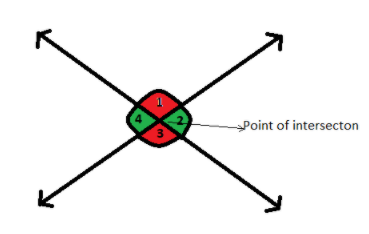
How many angles are formed by two intersecting lines?
A) 2
B) 4
C) 8
D) None of these
Answer
564.9k+ views
Hint:
Here, we have to use the basic concepts of geometry. In geometry two intersecting lines always intersect each other at a point and that point is called a point of intersection. We will draw a figure of two intersecting lines. Then we will analyze at the point of intersection to find out the number of angles formed by the intersection of two lines.
Complete step by step solution:
Firstly we will draw a figure of two intersecting lines

Here, from the diagram we can see that, when two lines intersect, at a point of intersection, four angles are formed. We can say that \[\angle 1 = \angle 3\] and \[\angle 2 = \angle 4\] because these are vertical opposite angles (vertical angles).
Thus, we can conclude that there are four angles formed by two intersecting lines.
So, option B is correct.
Note:
At a single point of intersection, more than two lines can intersect.
Here are some properties of intersecting lines:
The intersecting lines meet only at one point always even if they are more than 2 lines.
The lines can intersect with each other at any angle. This angle formed is always greater than \[0^\circ \] and less than \[180^\circ \].
Here are some real life examples of intersecting lines are railway tracks, crossroads, hour hand and minute hand in a clock, scissors etc
Vertically Opposite Angles (vertical angles) are the angles opposite each other when two lines intersect or cross each other and pairs of vertically opposite angles (vertical angles) are always equal to each other.
Here, we have to use the basic concepts of geometry. In geometry two intersecting lines always intersect each other at a point and that point is called a point of intersection. We will draw a figure of two intersecting lines. Then we will analyze at the point of intersection to find out the number of angles formed by the intersection of two lines.
Complete step by step solution:
Firstly we will draw a figure of two intersecting lines

Here, from the diagram we can see that, when two lines intersect, at a point of intersection, four angles are formed. We can say that \[\angle 1 = \angle 3\] and \[\angle 2 = \angle 4\] because these are vertical opposite angles (vertical angles).
Thus, we can conclude that there are four angles formed by two intersecting lines.
So, option B is correct.
Note:
At a single point of intersection, more than two lines can intersect.
Here are some properties of intersecting lines:
The intersecting lines meet only at one point always even if they are more than 2 lines.
The lines can intersect with each other at any angle. This angle formed is always greater than \[0^\circ \] and less than \[180^\circ \].
Here are some real life examples of intersecting lines are railway tracks, crossroads, hour hand and minute hand in a clock, scissors etc
Vertically Opposite Angles (vertical angles) are the angles opposite each other when two lines intersect or cross each other and pairs of vertically opposite angles (vertical angles) are always equal to each other.
Recently Updated Pages
Master Class 9 General Knowledge: Engaging Questions & Answers for Success

Master Class 9 English: Engaging Questions & Answers for Success

Master Class 9 Science: Engaging Questions & Answers for Success

Class 9 Question and Answer - Your Ultimate Solutions Guide

Master Class 12 Economics: Engaging Questions & Answers for Success

Master Class 12 Maths: Engaging Questions & Answers for Success

Trending doubts
Which places in India experience sunrise first and class 9 social science CBSE

Fill the blanks with the suitable prepositions 1 The class 9 english CBSE

Write the 6 fundamental rights of India and explain in detail

Difference Between Plant Cell and Animal Cell

What is pollution? How many types of pollution? Define it

What is the Full Form of ISI and RAW




